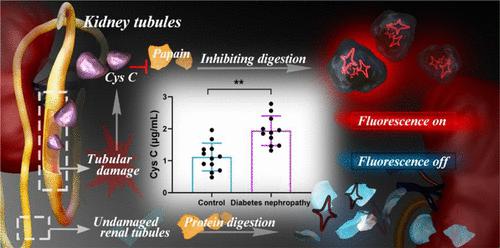Our official English website, www.x-mol.net, welcomes your
feedback! (Note: you will need to create a separate account there.)
A Non-Immunized and BSA-Template Aggregation-Induced Emission Sensor for Noninvasive Detection of Cystatin C in the Clinical Diagnosis of Diabetes Nephropathy
ACS Sensors ( IF 8.2 ) Pub Date : 2023-03-06 , DOI: 10.1021/acssensors.2c02122 Shujing Chen 1, 2 , Kunze Du 1, 2 , Shuangqi Wang 1, 2 , Chunxiao Liang 1, 2 , Ye Shang 1, 2 , Xiaoyuan Xie 3 , Ge Tang 3 , Jin Li 1, 2 , Bing Wang 4 , Xie-An Yu 4 , Yanxu Chang 1, 2
ACS Sensors ( IF 8.2 ) Pub Date : 2023-03-06 , DOI: 10.1021/acssensors.2c02122 Shujing Chen 1, 2 , Kunze Du 1, 2 , Shuangqi Wang 1, 2 , Chunxiao Liang 1, 2 , Ye Shang 1, 2 , Xiaoyuan Xie 3 , Ge Tang 3 , Jin Li 1, 2 , Bing Wang 4 , Xie-An Yu 4 , Yanxu Chang 1, 2
Affiliation

|
Diabetes nephropathy (DN) is one of the main causes of death in patients with diabetes. Cystatin C (Cys C) is a reliable indicator of glomerular filtration function. Therefore, it is urgent and meaningful to obtain early warning of DN by noninvasive measurement of Cys C. In this investigation, a novel fluorescence sensor (BSA-AIEgen sensor) was synthesized by cross-linking the aggregation-induced emission (AIE) characteristics of 2-(4-bromophenyl)-3-(4-(4-(diphenylamino) styryl) phenyl) fumaronitrile (TPABDFN) and bovine serum albumin (BSA), which exhibited the “On” state owing to the restriction of the intramolecular motions (RIM) phenomenon of TPABDFN. Intriguingly, a decrease in fluorescence of BSA-AIEgen sensors could be found owing to BSA on the surface of BSA-AIEgen sensor hydrolyzed by papain, but a reverse phenomenon emerged with the increase of Cys C content as the inhibitor of papain. Hence, Cys C was successfully detected by employing the fluorescent differential display and the linear range was from 12.5 ng/mL to 800 ng/mL (R2 = 0.994) with the limit of detection (LOD) of 7.10 ng/mL (S/N = 3). Further, the developed BSA-AIEgen sensor successfully differentiates patients with diabetes nephropathy from volunteers with the advantages of high specificity, low cost, and simple operation. Accordingly, it is expected to become a non-immunized method to monitor Cys C for the early warning, noninvasive diagnosis, and drug efficacy evaluation of diabetes nephropathy.
中文翻译:

用于糖尿病肾病临床诊断中胱抑素 C 无创检测的非免疫和 BSA 模板聚集诱导发射传感器
糖尿病肾病(diabetes nephropathy,DN)是糖尿病患者死亡的主要原因之一。胱抑素 C (Cys C) 是肾小球滤过功能的可靠指标。因此,通过无创测量 Cys C 获得 DN 的早期预警是紧迫且有意义的。在本研究中,通过交联 Cys C 的聚集诱导发射(AIE)特性合成了一种新型荧光传感器(BSA-AIEgen 传感器)。 2-(4-溴苯基)-3-(4-(4-(二苯基氨基)苯乙烯基)苯基)富马腈(TPABDFN)和牛血清白蛋白(BSA),由于分子内运动的限制而呈现“On”状态(RIM) TPABDFN 现象。有趣的是,由于 BSA-AIEgen 传感器表面的 BSA 被木瓜蛋白酶水解,可以发现 BSA-AIEgen 传感器的荧光减少,但随着作为木瓜蛋白酶抑制剂的Cys C含量的增加,出现了相反的现象。因此,采用荧光示差显示成功检测到Cys C,线性范围为12.5 ng/mL至800 ng/mL(R 2 = 0.994),检测限 (LOD) 为 7.10 ng/mL (S/N = 3)。此外,开发的 BSA-AIEgen 传感器成功区分糖尿病肾病患者和志愿者,具有特异性高、成本低、操作简单等优点。因此,有望成为监测Cys C的非免疫方法,用于糖尿病肾病的早期预警、无创诊断和药效评价。
更新日期:2023-03-06
中文翻译:

用于糖尿病肾病临床诊断中胱抑素 C 无创检测的非免疫和 BSA 模板聚集诱导发射传感器
糖尿病肾病(diabetes nephropathy,DN)是糖尿病患者死亡的主要原因之一。胱抑素 C (Cys C) 是肾小球滤过功能的可靠指标。因此,通过无创测量 Cys C 获得 DN 的早期预警是紧迫且有意义的。在本研究中,通过交联 Cys C 的聚集诱导发射(AIE)特性合成了一种新型荧光传感器(BSA-AIEgen 传感器)。 2-(4-溴苯基)-3-(4-(4-(二苯基氨基)苯乙烯基)苯基)富马腈(TPABDFN)和牛血清白蛋白(BSA),由于分子内运动的限制而呈现“On”状态(RIM) TPABDFN 现象。有趣的是,由于 BSA-AIEgen 传感器表面的 BSA 被木瓜蛋白酶水解,可以发现 BSA-AIEgen 传感器的荧光减少,但随着作为木瓜蛋白酶抑制剂的Cys C含量的增加,出现了相反的现象。因此,采用荧光示差显示成功检测到Cys C,线性范围为12.5 ng/mL至800 ng/mL(R 2 = 0.994),检测限 (LOD) 为 7.10 ng/mL (S/N = 3)。此外,开发的 BSA-AIEgen 传感器成功区分糖尿病肾病患者和志愿者,具有特异性高、成本低、操作简单等优点。因此,有望成为监测Cys C的非免疫方法,用于糖尿病肾病的早期预警、无创诊断和药效评价。











































 京公网安备 11010802027423号
京公网安备 11010802027423号